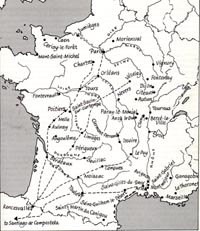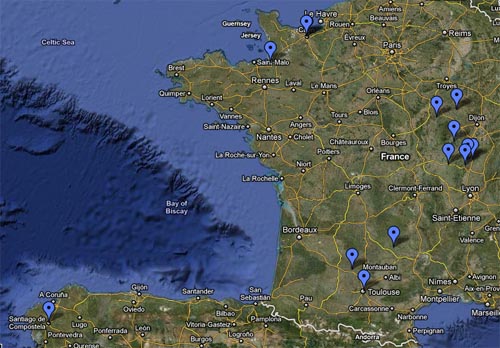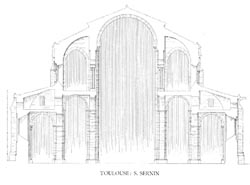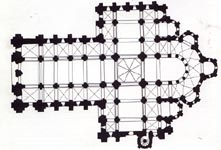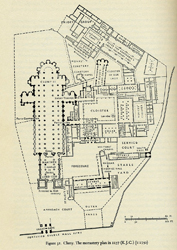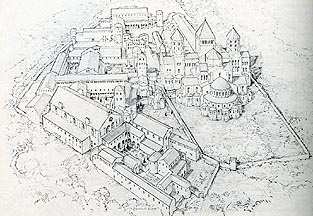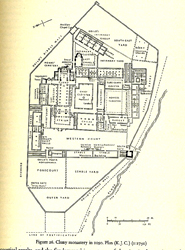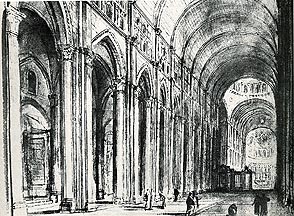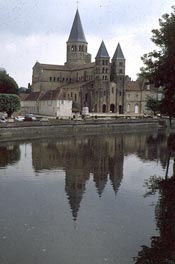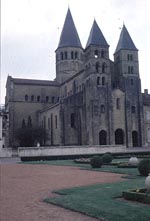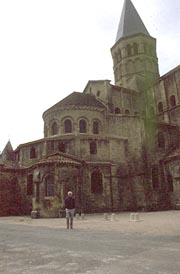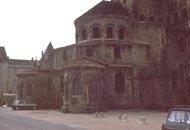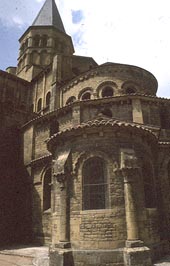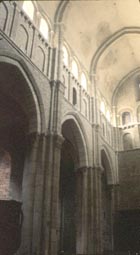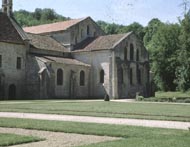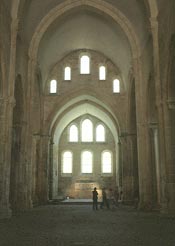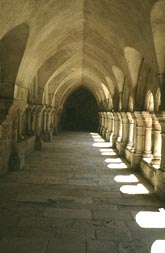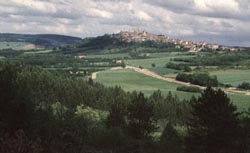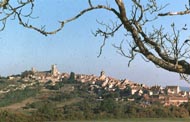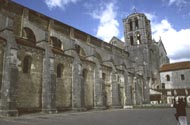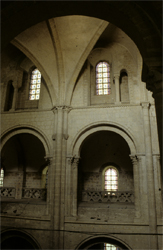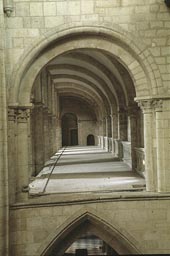| St. Sernin
at Toulouse: construction began about 1060 and the nave
was vaulted about 1119. |
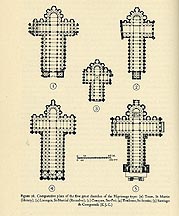
Plans
of the Pilgrimage Route Churches
|
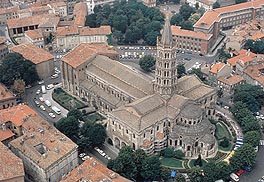 |
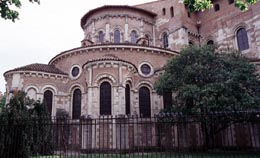
East
end of St.Sernin showing Choir, ambulatory, and radiating chapels.
|
|
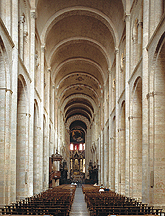
Nave
with barrel or tunnel vault. Nave elevation formed of nave arcade
with gallery above.
|

Barrel
Vault with transverse arches connected to attached half columns that
extend down to compound piers.
|
|
|
|
| |
|
| St. Foi
at Conques: mostly built between 1100 and 1130. |
|
|
|
|
|

Cross
Section showing gallery. The thrust of the nave vault is transmitted
down the half barrel vaults in the gallery. Diaphragm arches reinforce
half barrel vaults. Wall buttresses on the exterior contain thrust.
|
| Cluny
III: Abbot Hugh (1049-1109) began the rebuilding of the
Abbey Church at Cluny in 1088. Construction continued for the next forty-two
years. The five aisled nave was completed in 1121 under Abbot Pons (1109-22). |
|
|
|
|
|
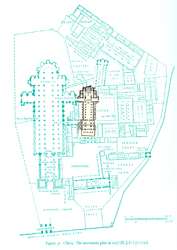
Plan of the church of Cluny II superimposed on the plan of Cluny III.
|
|
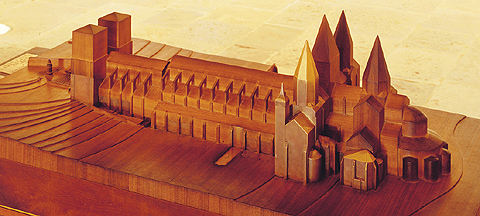 |
|
Comparisons:
One of the innovations at Cluny III was the introduction of pointed
barrel vaults. A possible source is Islamic architecture. Islamic architecture
influenced the architecture of sourthern Italy. The pointed arch apparently
was used in the now lost church of St. Benedict at Montecassino, the
mother church of the Benedictine order. The church of San Angelo in
Formis uses pointed arches.
|
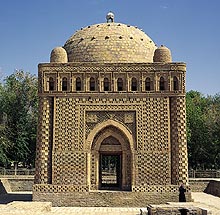
Mausoleum
of the Samanids, Bukhara, Uzbekistan, early 10th century.
|
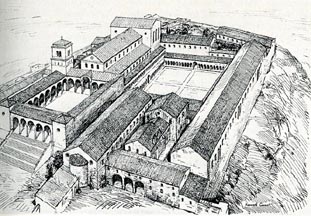
Reconstruction
of the monastery of Montecassino.
|
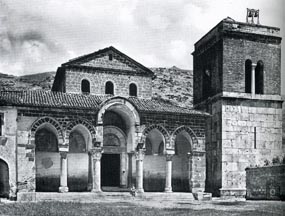
Facade
of San Angelo in Formis, Capua, 1058-1075. The church was begun by
Abbot Desiderius of Montecassino.
|
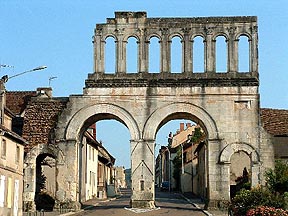
Autun,
Porte d'Arroux, Roman city gate, 1st century A.D.. Compare to the
treatment of the nave elevations of St. Lazare at Autun and Paray
le Monial.
|
| Paray-le-Monial:
built between 1080 and 1130. Nave was constructed between
1120s and 1130s. Strongly influenced by Cluny III. |
|
|
|
|
|
|
|
|
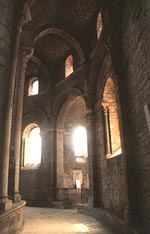
Ambulatory
with radiating chapel.
|
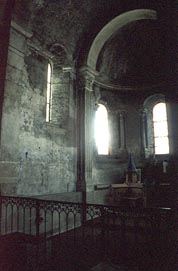
Radiating
chapel.
|
|
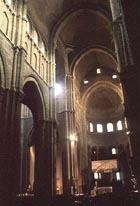
Pointed
arches appear in the nave arcade and the nave is roofed with a pointed
barrel vault. The pointed arches and vault emphasize the verticality
of the building.
|
|
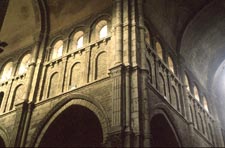
Nave
elevation: nave arcade, triforium, and clerestory. Note the use of
pilaster forms to articulate the divisions in the triforium and clerestory.
|
|
| St. Lazare
at Autun: built between 1120 and 1146. |
|
|
|
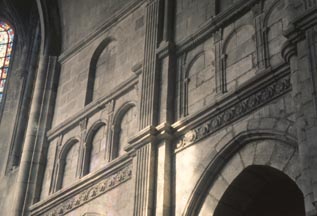
Choir
of St. Lazare showing the articulation of the nave wall with classicizing
pilasters and arcades. Capitals are variations of Corinthian capitals.
|
| |
|
| Cistercian Abbey at Fontenay: founded in 1118 by St. Bernard, begun
in 1130 by Bishop Everhard of Norwich, and consecrated in 1147. |
|
|
|
|
|
|

Pointed
barrel vault.
|
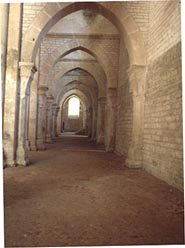
Transverse
barrel vaults of side aisle.
|
|
|
|
|
| Ste.
Madeleine Vézelay: This Burgundian monastery was
believed to possess the relics of Mary Magdalene. Consquently, this abbey
became an important destination for pilgrims. The building was largely
built between 1120 and 1132. The choir was done in the Early Gothic period,
1185-1190. |
|
|
|
|
|
|
|
|
|

Nave
with groin vault.
|
|
| |
|
|
St. Étienne
at Caen: or Abbaye aux Hommes, founded by William the
Conqueror in 1064 and dedicated in 1077. Vaulted about 1130-35.
|
|
|
|
|
|
|
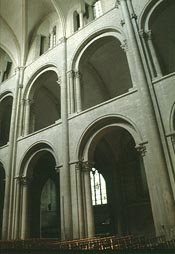
Nave
elevation: nave arcade, gallery, and clerestory. Note the alternation
in the compound piers with one composed of pilaster and half column
and the other with simply a half column. This alternation connects
to the sexpartite rib vault above.
|
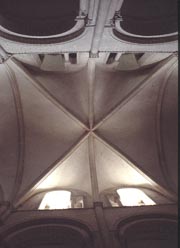
Sexpartite
ribbed vault.
|
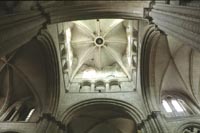
Crossing
|
|
|
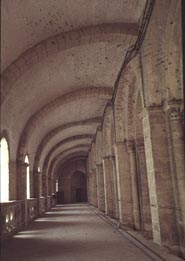
Gallery
with half barrel vaults thickened by ribs. Thrust of nave vault is
transmitted through ribs to external wall buttresses.
|
| |
|
| |
|
| |
|
| |
|
| |
|


